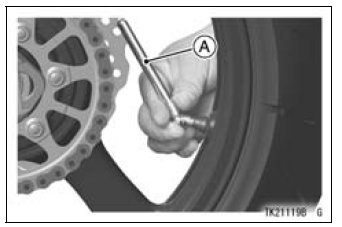

Failure to maintain proper inflation pressures or observe payload limits for your tires may adversely affect handling and performance of yourmotorcycle and can result in loss of control. The maximum recommended load in addition to vehicle weight is 180 kg (397 lb), including rider, passenger, baggage, and accessories.
NOTE

A. Tire Pressure Gauge
Tire Air Pressure (when cold)

 Wheels
Wheels Tire Wear, Damage
Tire Wear, DamageIdle Speed Control Valve Actuator Removal
NOTICE
Never drop the idle speed control valve actuator especially
on a hard surface. Such a shock to the actuator
can damage it.
Remove:
Throttle Body Assy (see Throttle Body Assy Removal in
the Fuel System (DFI) chapter)
Idle Speed Control Valve Actuator Retainer Screws [A]
Idle Spe ...
Spring Tension Inspection
Since a spring becomes shorter as it weakens, check its
free length [A] to determine its condition.
If the spring of either fork leg is shorter than the service
limit, it must be replaced. If the length of a replacement
spring and that of the remaining spring vary greatly, the
remaining s ...
Idle Speed Control Valve Actuator Resistance Inspection
Turn the ignition switch to OFF.
Remove the air cleaner housing (see Air Cleaner Housing
Removal in the Fuel System (DFI) chapter).
Disconnect the idle speed control valve actuator connector
[A].
Connect a digital meter to the idle speed control valve
actuator connector [A]
...